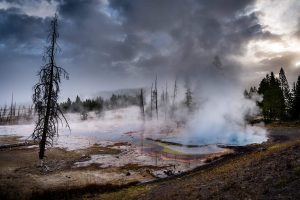When thinking about energy sources, conventional or renewable, hardly anyone comes up with the earth. However, this is where renewable energy has come from for over 100 years.

Along with their popularisation, renewable energy sources are also becoming more and more advanced. Therefore, their efficiency and thus attractiveness has increased. Of course, not all of them are equally efficient. One of the least efficient is geothermal energy. How exactly is geothermal energy sourced, what is its history, and is it used on a large scale despite its drawbacks?
The earth provides food and… energy
First of all, let’s say what geothermal energy is. As the name suggests, it is energy sourced from the inside of the earth. The source might be rocks, water or even soil. It is obtained through drilling, similar to oil wells. When using geothermal sources, care should be taken not to cool the source. The process of restoring geothermal sources is slow and thus, not allowing the source to cool down is crucial. Their efficiency is related to this feature as not every source is large enough to supply the same amount of energy as, for example, from the sun.
A look back
At the turn of the 19th and 20th century, energy demand rapidly increased. For this reason, an alternative was sought for coal – the popular energy source at that time. There was, therefore, a turn towards the ground, which had after all already given us food – so why not start looking for other energy sources there as well? The first successful prototype of a geothermal energy plant was build in Larderello, Italy, in 1904. It was set up by Prince Piero Ginori Conti and used to light up four bulbs. In 1911, the first commercial geothermal energy plant was established there. Experimental generators were also built in Japan and the US; however, until 1958, Italy was the only commercial producer of geothermal energy.
A niche source?
It was not until 1958 when another country – New Zealand – joined Italy. It happened with the opening of a power plant in Wairakei. Since then, New Zealand has built more power plants based on geothermal energy, making it the source of 15% of the country’s energy. There are, however, countries that obtain even more domestic energy from this source. These are the Philippines and Iceland. Geothermal energy accounts for almost 24% and 26% of their domestic energy production, respectively. However, due to the aforementioned limitations and problems, in other countries the share of geothermal energy does not exceed a dozen or so percent. Hence, it can be considered a niche source.
Geothermal energy in the PCC Group
Among the companies of the PCC Group, a special mention deserves to go to PCC Bakki Silicon. The company’s headquarters are located in Iceland. There, in one of the world’s most modern production facilities, silicon metal production takes place. The plant’s offer also includes microsilica. Only energy from ecological geothermal sources is used to supply power for production. This allows for offering the highest quality silicon metal with over three times lower carbon dioxide emissions than other plants.
Regardless of the limitations, some countries have decided to choose this unconventional source of energy. It is estimated that due to the technological development and growing popularity of renewable sources of energy in general, by 2050, geothermal energy will be able to meet 3-5% of the world’s energy needs and, by 2100, this number will double and reach around 10%.
Sources:
https://www.mbie.govt.nz/building-and-energy/energy-and-natural-resources/energy-generation-and-markets/geothermal-energy-generation/
https://nzgeothermal.org.nz/geothermal-energy/electricity-generation/
https://www.thinkgeoenergy.com/geothermal-in-the-philippines-an-urgent-revamp-of-targets-and-development-needed/